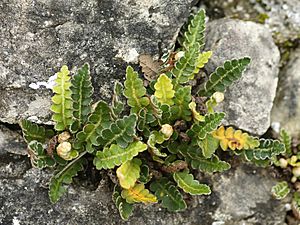Rustyback Fern facts for kids
Quick facts for kids Rustyback |
|
|---|---|
 |
|
| Conservation status | |
| Scientific classification | |
| Genus: |
Asplenium
|
| Species: |
ceterach
|
| Synonyms | |
|
Ceterach officinarum Willd. |
|
The Rustyback fern (also known as Asplenium ceterach) is a special type of plant. It gets its common name from the rusty-brown hairs found on the underside of its leaves. This fern is famous for being able to dry out almost completely and then come back to life when it gets water!
Contents
What Does the Rustyback Fern Look Like?
The Rustyback fern has a short underground stem called a rhizome. From this rhizome, several green leaves grow. These leaves are called fronds.
Each frond has a main leafy part that is divided into many smaller sections. On the bottom side of these fronds, you will find tiny, orange-brown hairs. These hairs are called trichomes, and they are why the fern is called "rustyback." The top side of the fronds does not have these hairs. The stem of the leaf (called the petiole) is shorter than the main leafy part.
Where Does the Rustyback Fern Live?
This fern is found in many parts of Western and Central Europe. This includes countries around the Mediterranean Sea.
The Rustyback fern loves to grow in cracks in rocks, especially those made of limestone. You can also find it growing on the mortar of old stone and brick walls. It can grow very high up, even at 2,700 meters (about 8,850 feet) above sea level. It prefers sunny, rocky walls and slopes in mountainous areas.
Unlike many other ferns, the Rustyback fern enjoys growing in full sun. It also needs very little moisture to survive.
How Does the Rustyback Fern Survive Drying Out?
The Rustyback fern is known as a "resurrection plant." This means it can handle drying out almost completely and then recover when it gets water again. It's like it comes back to life!
Scientists have found that this fern has special compounds that help it survive. These include things like chlorogenic acid and caffeic acid. These compounds help protect the fern from damage when it dries out. The fern also produces more of certain enzymes, like peroxidase, when it doesn't have enough water. These enzymes also help it cope with dry conditions.
Traditional Uses of Rustyback Fern
For a long time, people have used the Rustyback fern to make special drinks. These drinks were often used as a diuretic, which helps the body get rid of extra water.
See also
 In Spanish: Ceterach officinarum para niños
In Spanish: Ceterach officinarum para niños


